Narthaki

News

Info

Featured


|
 |
Jhelum 60, Smitalay 25 - Lalitha Venkat e-mail: lalvenkat@yahoo.com Photos courtesy: Smitalay October 18, 2014 Jhelum Paranjape is a leading dancer, teacher and choreographer of Odissi. Her school Smitalay is the dance wing of Sane Guruji Arogya Mandir, where Odissi is actively taught and performed. Jhelum's long-standing association with her guru and mentor Kelucharan Mohapatra has blossomed into a beautiful and creative relationship with Odissi. Noted for her originality in choreography, technique and stage design, her versatility ranges from classical Odissi dance to experimental dance movements. She reaches out to the audiences by creating new mediums for expressing unique contemporary issues through her dance. Some of her popular productions include 'Leelavati' showcasing mathematics through dance, 'Bollywood Hungama Odissi Ishtyle' of Odissi dance choreographed to old and new Hindi film songs from the 40's to the present day, 'Jalasri' depicting conservation of water and nature, 'Meghadoot' based on a Marathi translation of Kalidasa's epic Meghadootam, 'Savitri Vadatey' conveying the importance of women education. Her solo productions include 'Jani mhaney' based on the abhangs of saint poet Janabai and 'Maeri' portraying the bond of motherhood. Jhelum has been honored with Sanskrutik Puraskar from the Maharashtra govt, Sanjukta Panigrahi National Award, Mahari Puraskar for performing and propagating Odissi dance nationally and internationally (She is the first non-Odiya dancer to receive it), Kumar Gandharva Puraskar for popularizing and propagating Odissi in Maharashtra. Smitalay completes 25 years on 17th October 2014. The start of a yearlong celebration is a 5 day festival spread over 4 venues in Mumbai featuring 6 of Smitalay's productions. Jhelum talks about her dance journey. Did you not start learning Odissi rather late, from around age 20? Well, yes I did start "rather late" in terms of studying any particular traditional classical dance style. I started Odissi at the age of 22 from Guru Shankar Behera. But I'd been doing folk dance since the age of 5 or 6, with the group Rashtra Seva Dal Kalapathak. Also, dance, grace, rhythm was kind of naturally just there in my body plus I think I was born with the love of dance. It was genetic. You see, my mother was a great lover of dance and a very graceful dancer herself. In fact, she was very keen that I do classical dance. She tried Bharatanatyam and then Kathak, but I did not take to both. On one of our folk dance performance tours, I saw Guruji (Kelucharan Mohapatra) teaching at Kala Vikas Kendra, Cuttack, and my heart was set on Odissi. I was in the XI grade but there was no Odissi guru in Mumbai city then. 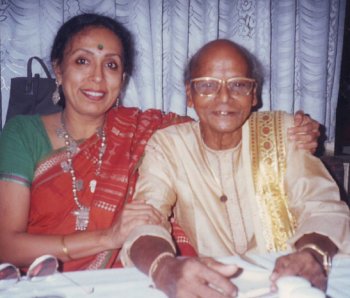 Jhelum and Kelubabu at his favorite restaurant in Mumbai, Gazalee 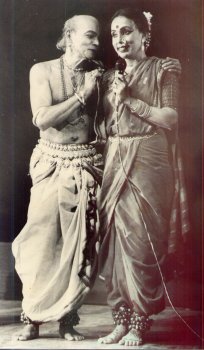 Kelubabu and Jhelum in Ekakar, 1998 Could you tell us about your training with Kelubabu? I will narrate my first meeting with Guruji and then go on to tell you about my training with him. Smita Patil and I were childhood friends. In fact, she and I started learning Odissi together from Shankar Behera. She did the basics for six months and then director Shyam Benegal discovered her. At some film party she met Protima Bedi who happened to very proudly mention that she's organising a workshop by none other than Guru Kelucharan Mohapatra. So the very next day Smita and I visited Protima. She made me do a portion of batu nritya (supposed to be difficult) to test me, she liked it and asked me to meet Guruji. He made me dance too and said, "Acchhaa kartaa hai, aajao mere paas." (You dance well, you can come to me). That's how training with him began, and there was no stopping till his death. I had training under him at his home in Cuttack, Odisha and also in workshops at NCPA, Mumbai. At Cuttack, it was absolutely a gurukul. Dance, dance, dance and also do housework. It was tiring, but it was fun. Get up in the morning, do warm up exercises and start class with him. The teaching and dancing would go on till Guruma would call us for breakfast. Then teaching and dancing again till she'd call us for lunch. Lunch could be anytime between 2 and 4pm. Post lunch compulsory rest, no dancing. He was very strict about it. Then we'd start again around 5 to 6pm, have a bit of a snack around 8pm and then go on till 11, 12 in the night. Guruma would literally have to force him to stop class and leave us for dinner. Quite often, post 12 in the night, Sanju nani and Raghu bhaina (Sanjukta and Raghunath Panigrahi, the couple who placed Odissi on the pedestal it is today), would drop in either for a rehearsal or for a new composition. That was a treat as well as a great learning experience that we got. At NCPA it was different. Classes would begin at a particular time, break for lunch would not be too late and pack up was usually latest by 8pm, unless there was a program at NCPA, then we'd stop by 6pm. Guruji's teaching was out of this world. His attention to all the nuances - he'd make a great effort to make us understand the subtle nuances of the Odissi style. He'd take tremendous pains to get our bodies into the perfect posture/pose that he wanted. I'd say he actually sculpted our bodies to mould into the Odissi format that he so loved. He'd physically push our torso to get it in the right tribhangi position in such a way, that we'd never ever forget it. He made sure that we'd never ever forget it so much so that we'd even teach our students the same way, and that's exactly what I have done over the years. He was a darling, he loved us like a mother or father would, but he was a terrible taskmaster. He had that stick in his hand which would fly perfectly in the direction of a student's body part that had gone wrong...!!! Some of us would jump to avoid being hurt, but rarely were we successful in that. I remember one incident. My mudra was not perfect - not perfect to his eyes - so he called me up close to him and asked me to do the mudra again. I tried hard, but no, the old man wasn't satisfied. THAK - the stick came down on my ring finger, tears welled up in my eyes - a natural reaction to the pain I experienced, but we knew he hated tears. Had he noticed my tears he would have thrown me out of class. That didn't happen. But the best part of this story is that after class, as we all were moving for lunch (this happened at his Cuttack home), he called me, made me sit near him, gently held my hand and caressed the part he had hit. He then said to me, "Did it hurt a lot? Look. I want you to be perfect, be excellent at what I teach you, give you...and I know you have it in you, so when it does not happen, when you don't do it, it upsets me." Now, when one gets this kind of love, affection and attention, who cares how much and how often one is hurt?? On our Russia tour for festival of India, I had a back problem. We were a group of 30, musicians and dancers, but amongst all he remembered that my back was bad and did not let me pick up heavy things. After you started your career with a US tour, you had health setbacks. How did that affect you? Health setbacks...major...it was a herniated or slipped disc that I suffered. I had to cancel 5 of my fag end performances and return to India. My solo career had just taken off so very elegantly and thud....it landed flat on the ground. Had I suffered the herniated disc after completion of my US tour, I'd have repeatedly gone to the US as all do, right from 1988 for performances and workshops. But destiny had something else in her mind. And I too feel this was a blessing in disguise. Smitalay happened because of my slipped disc. I came back on a wheelchair, as there was excruciating pain going down through my right leg and it was impossible to walk. One doctor's advice was spinal surgery, then no dancing, but returning to math and stats. This was shattering news to me. But another one said, "I will operate, meaning I will kind of mess up the muscles of your back to set the spine right, but then, after this, you will dance again, so where is the guarantee that this will not recur? So, I will adopt the orthodox method. No surgery. You will take complete bed rest for a full month, and no getting up even to go to the toilet. After that one month, we will see if you can dance or not." I loved him, because there was some hope of going back to dance... how could I just leave dance, my current and steady love, and go back to math and stats - my ex flame? But it did set me thinking. Just suppose I cannot dance the way I did...meaning full-fledged solo performances of two hours, with vigorous dancing?? Then what do I do? My life was dance. I had already started teaching in a wee bit way, to some of my friend's kids at this charitable trust - Sane Guruji Arogya Mandir. I thought very deeply and came to a conclusion. If I cannot dance the way I did, I can definitely teach. Teaching does not require the kind of vigorous, strenuous dancing that a performance does. I thought of a school, and as Smita had died just 2 years ago, I thought of naming the school after her and that's how Smitalay happened. Your question was "How did the health setback affect you?" My answer to that is "it affected me in a very positive and constructive manner." Can you tell us about how you started your work with the underprivileged children and how far has it progressed? I started teaching at Sane Guruji Arogya Mandir, a charitable trust working for the underprivileged. It also runs a Marathi medium school for their children. My parents were associated with the trust right at the onset. As a child I visited this place often. I grew to love the atmosphere here. All our folk dance rehearsals happened here. Many of these underprivileged adults and children were part of the folk dance troupe. I had friends here. When I fell in love with Odissi and took it up professionally, I thought, this dance gives me so much pleasure and satisfaction, let me share it with these people, let me pass on my love to them. And so I started teaching here. I started at Rs 5 fee a month. The girls were very enthusiastic, because this was something so totally new and different for them. They would attend class very excitedly. But it was quite a task to convince the parents to send their wards. For them it was a waste of time. "What is she going to gain by learning dance...she might as well help us in housework after school hours." Now two girls and one boy from underprivileged backgrounds are professional dancers and teachers at Smitalay. Many others are part of the Smitalay performing group. Many parents now value the fact that their kids are doing classical dance. This indeed is progress. 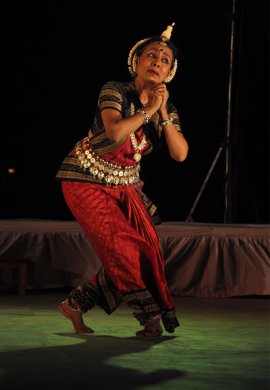 Krishna begs Radha's forgiveness 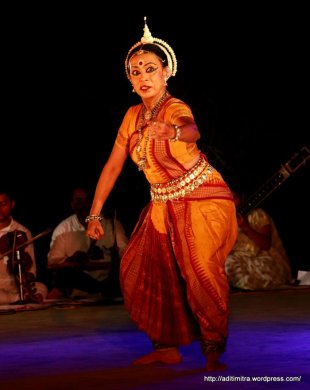 Dushasan disrobing Draupadi When you started your school, did you dream that you would successfully be completing 25 years? What have been your most rewarding achievements / experiences through these years? The only thing I dreamt about was dance - teaching dance, creating dance and seeing the dance being performed by the students at Smitalay. The years just flew by and the successful journey of 25 years is not just due to me. So many others have contributed. Some of my most rewarding achievements / experiences through these years are: - I have been able to create dancers who have gone out and spread their wings to become solo dancers and teachers themselves. And yet come back when Smitalay needs them, as is happening in this 5 day festival. - I have created several dance pieces, productions showcasing social, political, ecological, feminist, educational, spiritual themes and thus reached out to several people, a large audience. - It's not that Smitalay has only underprivileged students coming here. We have students from the middle and upper strata of society too. It's very rewarding to see them mingle freely, see no hierarchy, see a beautiful homogeneous group. Be it in class or on stage. I remember senior Manipuri dancer Darshana Jhaveri once mentioning to me, "It feels so good to see your group. There is such a clear internal integrity and oneness amongst your dancers." You have set up a crowd funding project to raise funds for your school. Could you explain its workings, how the results have been and what you need the funds for / what are the immediate needs of your school? The crowd funding project is twofold. A crowd funding site is created for our NRI friends. They contribute in dollars through a particular link. The other is just reaching out to family, friends and well-wishers in India, mainly getting rupee contributions from them. This crowd funding aspect has a reason. The more people we contact, the more come to know what is Odissi and what is Smitalay. This way we might collect less than if we were to approach corporates for sponsorship. But this way we definitely reach out to many more people. The results have really been good. It's not that we've collected a huge amount, but we've got donations as small as Rs.500 and as large as 1 lakh. And on the dollar front, as small as $10 and as large as $1000. We require the funds for these main reasons. - Renovating our facilities. Years of training on cement and tiled floors have left many of our dancers injured. Wooden flooring will make Odissi at Smitalay more injury free. - Paying better salaries to Smitalay's teachers, all full-time dancers who must earn a living from their chosen profession, and simultaneously keep offering scholarships to underprivileged students as we've been doing over the years. 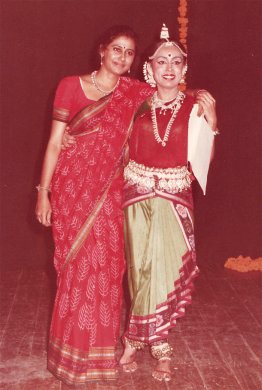 Smita Patil and Jhelum How have you planned to celebrate your turning 60 and your school turning 25? Is it a yearlong celebration? I did not plan to celebrate my 60th birthday at all. I was too busy in the preparations of Smitalay turning 25!! But my students gave me a wonderful surprise of a flash mob dancing close to the sea at 7am!! I turned 60 on 24th Sept. A student even video taped the full thing and uploaded it on youtube (youtube.com). Yes, it will be a yearlong celebration, starting with a 5 day Odissi dance festival between 11th and 19th Oct across four venues in Mumbai. The performances are not ticketed, enabling easy and widespread access. Smitalay always has ticketed programs. This time people are confused, they keep calling to find out where to get the tickets! Then throughout the year we will have two Odissi performances a month, solos - one by a Smitalay dancer and one by an outsider, on the Smitalay stage in the Sane Guruji Arogya Mandir hall. We will end the celebrations on 17th Oct 2015, with a gala show. 17th is Smita Patil's birthday... were she alive she'd have turned 60. How different is Odissi today from your days of learning under Kelubabu? There is a difference in the teaching methodology, not the teaching style. By methodology, I mean we do not have the kind of workshops that Guruji conducted. They were always a month long at NCPA and a month long or more at his Cuttack house. Nowadays, the workshops are a week long or even shorter. I just read about a 3 day workshop in which one of Guruji's beautiful and long ashtapadis is to be taught. To me, this just does not make sense. A minimum of a weeklong full day workshop is necessary for this. Your comments on the popularity of Odissi today and what more needs to be done. Odissi has become tremendously popular now. Earlier, people were only aware of mainly Bharatanatyam and Kathak. Now many more know about Odissi, many more want to learn Odissi and many are very keen to watch Odissi performances. With so many dancers moving all over the world performing and teaching, Odissi is seeing really good days ahead. I don't think any extra efforts need to be taken to popularise Odissi. What I've done in Mumbai and Maharashtra - using different themes and languages to reach out to a larger section of society - is being done by several dancers all over the world, in their own sweet way. Now that you have reached this milestone, what next? There is no next for me. There is a permanency for me. What was yesterday is today and will continue to be so tomorrow. Smitalay was named in the memory of my childhood friend Smita Patil. Just as in vidyalay, vidya +lay - the abode of vidya, knowledge, Smita + lay, the abode of Smita or a place where her memory is permanent. But Smitalay also means smit + tal + lay, a smile on the face, rhythm in the body and pace in the feet. It is born out of love, has strived to spread this love one beat at a time for the past 25 years and will continue to do so. Jhelum can be contacted at: jhelum@smitalay.com  Comments Wonderful interview with my Guruji! The only thing the article misses is her unique teaching methods, where Jhelum Tai adapts to what the student needs. She truly implements a "no child left behind" policy, so long as the student is motivated! Must be from her years as a professor. - Rajul Shah (Nov 17, 2014) I have been blessed to have been a student of Jhelumtai ever since I was 11. All those have learned from her will agree with me that she is the best teacher one could ask for and hence most loved by all. She is very progressive,open, creative, supportive, affectionate, understanding and positive which shows through all her work and even in this interview. Leaving the city of Mumbai, going far from her and the comfort zone of Smitalay, learning from different teachers, getting exposure to different world has made me realise all the more how lucky I am to have her in my life. - Perknima (Nov 21, 2014)  Post your comments Unless you wish to remain anonymous, please provide your name and email id when you use the Anonymous profile in the blog to post a comment. All appropriate comments posted with name & email id in the blog will also be featured in the site. |